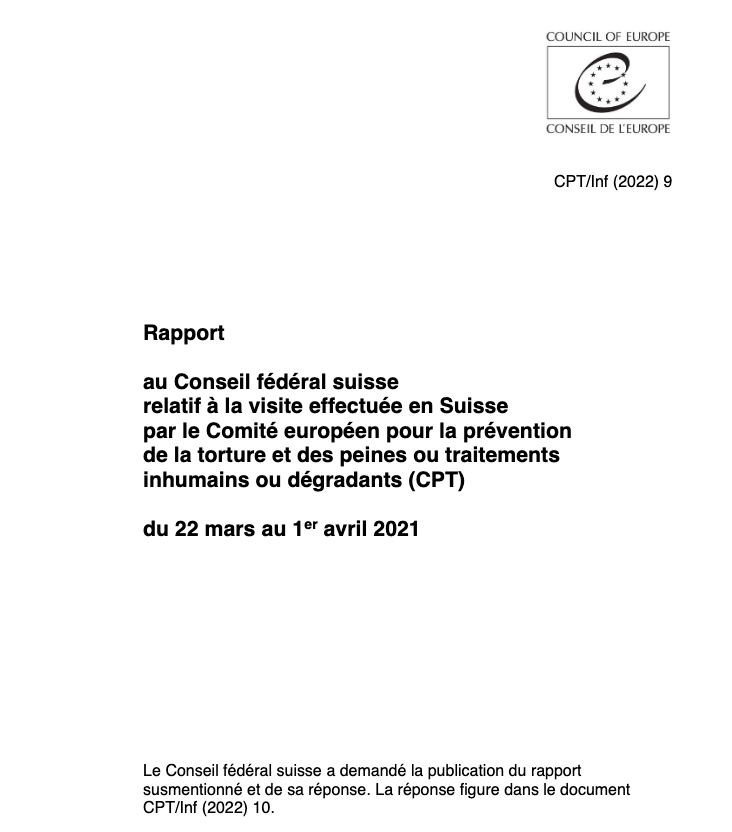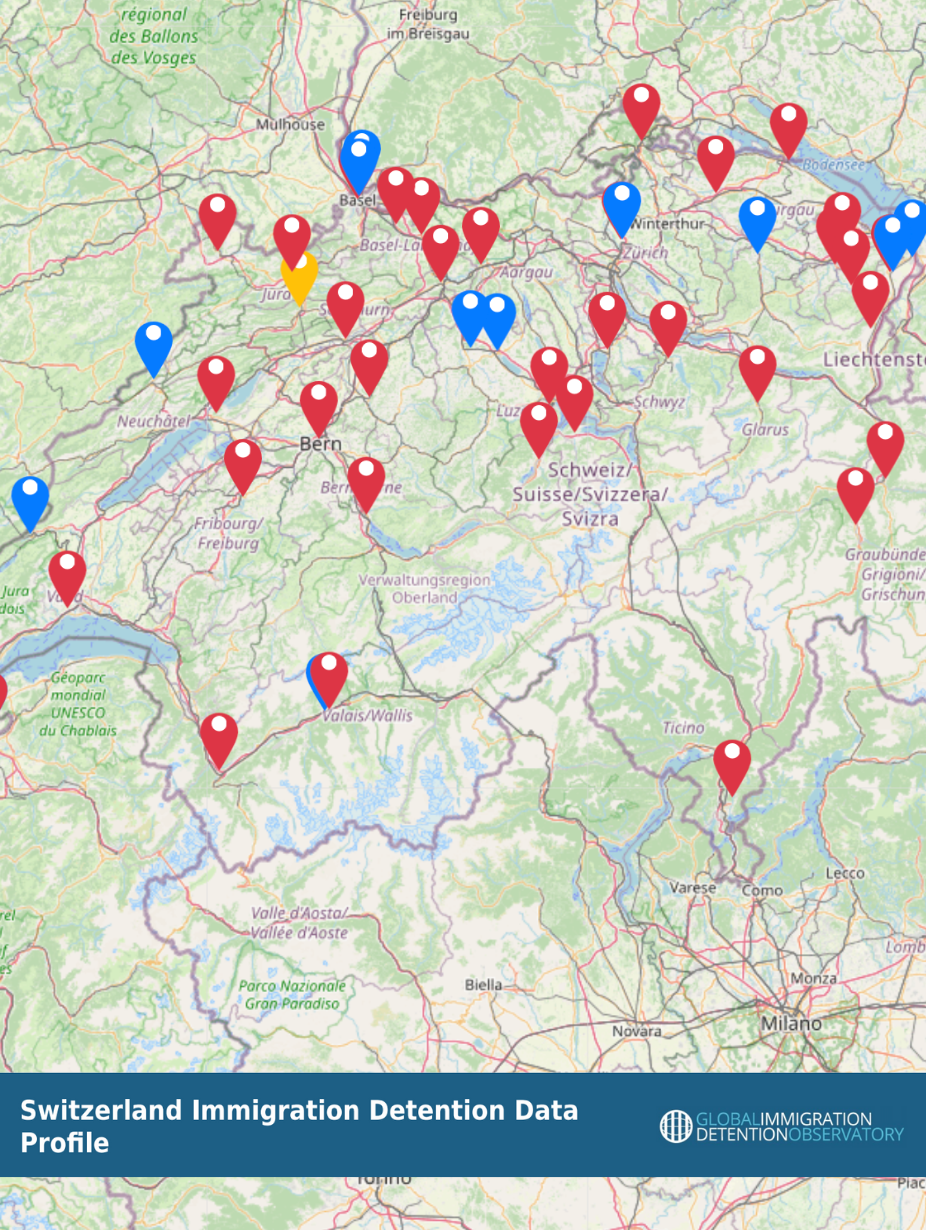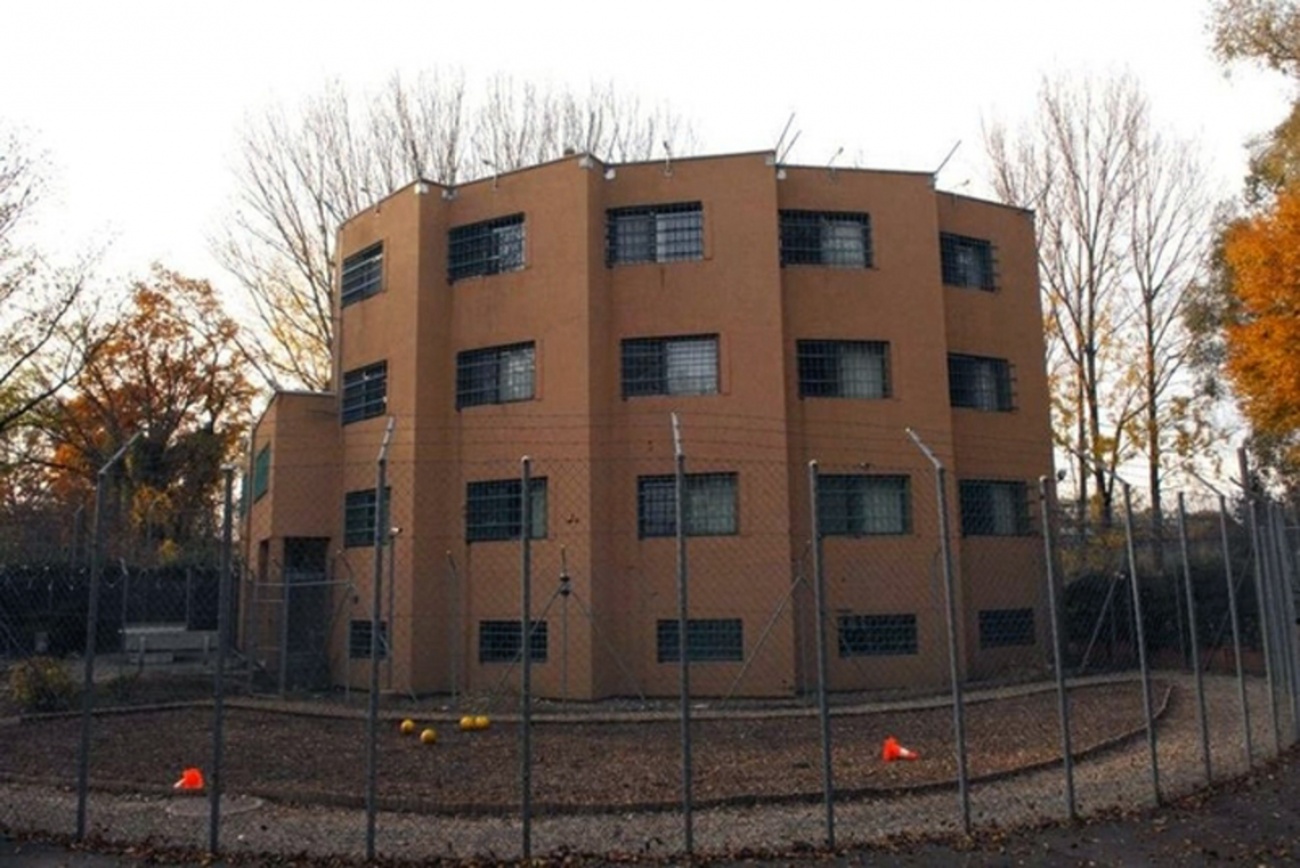In the morning of Saturday 8 April, a male immigration detainee was found unconscious in his cell in Geneva’s Favra detention facility. His death has prompted renewed calls for authorities to close the controversial centre. According to a press release from the Department of Security, Population and Health (DSPS), the man (reportedly a Tunisian awaiting […]
Switzerland: Covid-19 and Detention
In early May 2021, the Swiss immigration authority (Secrétariat d’Etat aux Migrations or SEM) launched an investigation into allegations of violence at federal asylum centres in Switzerland. The investigation followed the release of press reports about the use of excessive force by security officers when dealing with some asylum seekers. According to SEM, appropriate procedures […]

Flughafengefängnis, Boudry et Kantonaler Polizeiposten Flughafen In Switzerland (From the report of the European Committee for the Prevention of Torture 2021 visit to Switzerland)
E. Personnes faisant l’objet de mesures de contrainte en matière de droit des étrangers, (Read full CPT report) 236. Le CPT a examiné la situation des étrangers détenus en vertu de la législation sur les étrangers lors de sa visite en Suisse en 2007158. Au cours de la visite de 2021, la délégation a effectué […]

Switzerland: Covid-19 and Detention
On 26 January 2021, the SRF/RTS reported that the Asylum Departure Centre in Aarwangen was placed under quarantine by the Canton of Bern because 19 of its 100 inhabitants had tested positive for COVID-19. They also closed the facility’s kindergarten and school. On 29 January 2021, the Canton reported that the number of positive cases […]

Switzerland: Covid-19 and Detention
In a recent finding, the Committee on the Rights of the Child (CRC) concluded that Switzerland violated provisions in the UN Convention on the Rights of the Child when it failed to show due diligence in assessing a child’s best interests and did not take the child’s views into account in a case involving a […]

Switzerland: Covid-19 and Detention
As the GDP previously reported (see 27 June update), while Swiss authorities did not issue a moratorium on new detention orders during the pandemic, many immigration detainees were released due to the impossibility of conducting returns. This has been confirmed by Amnesty International Switzerland, which informed the GDP that some cantons declared a moratorium on […]

Switzerland: Covid-19 and Detention
Responding to the Global Detention Project Covid-19 survey, AsyLex reported that although Switzerland has not established a moratorium on new immigration detention orders, many immigration detainees have been released because returns are no longer possible. Certain local governments (cantonal authorities) have released all detainees, confirming information provided to the GDP by the Director General of […]

Switzerland: Covid-19 and Detention
Responding to the Global Detention Project’s Covid-19 survey, the Geneva Cantonal Population and Migration Office (Office Cantonal de la Population et des Migrations or OCPM) reported that while Geneva had not established a moratorium on new immigration detention orders, no new orders have been issued since the end of April, owing to the impossibility of […]

Switzerland: Covid-19 and Detention
Since the beginning of April, certain immigration detention centres, including the Frambois and Favra centres in Geneva, have been closed. Around 30 people were detained in the centres at the time. Reports suggest that they may have been assigned to a temporary residence or may be prohibited from entering a specific perimeter or region. The […]

Switzerland: Covid-19 and Detention
Swiss authorities have temporarily closed some immigration detention facilities, and detainees who have contracted the virus have been placed in isolation in prisons. In the early stages of the virus’ spread within the country, three Covid-19 cases were detected within federal asylum centres (Chevrilles, Basel, and Bern). Transfers between such facilities were subsequently reduced, but […]

Last updated: June 2020
DETENTION STATISTICS
Reported Detainee Population (Day)
DETAINEE DATA
DETENTION CAPACITY
ALTERNATIVES TO DETENTION
ADDITIONAL ENFORCEMENT DATA
PRISON DATA
POPULATION DATA
SOCIO-ECONOMIC DATA & POLLS
LEGAL & REGULATORY FRAMEWORK
Does the Country Have Specific Laws that Provide for Migration-Related Detention?
Detention-Related Legislation
Bilateral/Multilateral Readmission Agreements
GROUNDS FOR DETENTION
Immigration-Status-Related Grounds
Criminal Penalties for Immigration-Related Violations
Grounds for Criminal Immigration-Related Incarceration / Maximum Length of Incarceration
Has the Country Decriminalised Immigration-Related Violations?
LENGTH OF DETENTION
DETENTION INSTITUTIONS
Custodial Authorities
Detention Facility Management
PROCEDURAL STANDARDS & SAFEGUARDS
Types of Non-Custodial Measures (ATDs) Provided in Law
COSTS & OUTSOURCING
COVID-19 DATA
TRANSPARENCY
MONITORING
Types of Authorised Detention Monitoring Institutions
NATIONAL HUMAN RIGHTS MONITORING BODIES
NATIONAL PREVENTIVE MECHANISMS (OPTIONAL PROTOCOL TO UN CONVENTION AGAINST TORTURE)
NON-GOVERNMENTAL ORGANISATIONS (NGOS)
GOVERNMENTAL MONITORING BODIES
INTERNATIONAL TREATIES & TREATY BODIES
International Treaties Ratified
Ratio of relevant international treaties ratified
Relevant Recommendations or Observations Issued by Treaty Bodies
§ 13: The State party should reconsider the maximum period of administrative detention, resort to it only in exceptional circumstances and limit its duration in light of the principle of proportionality.
§ 17: The State party must also take measures to ensure that minors and adults, as well as detainees serving under different prison regimes, are separated. Finally, it must take steps to ensure the application of legislation and procedures concerning health-care access for all prisoners, especially those with psychiatric problems.
2010§ 17: The State party should develop and implement alternatives to administrative detention and should use detention only as a last resort, particularly where unaccompanied minors are concerned, and, when detention is necessary and proportionate, for as short a period as possible. The State should continue its efforts to provide special facilities in all cantons in order to accommodate migrants in administrative detention under an appropriate regime.
2015> UN Special Procedures
> UN Universal Periodic Review
Relevant Recommendations or Observations from the UN Universal Periodic Review
REGIONAL HUMAN RIGHTS MECHANISMS
Regional Legal Instruments
Relevant Recommendations or Observations of Regional Human Rights Mechanisms
HEALTH CARE PROVISION
HEALTH IMPACTS
COVID-19
Country Updates
Government Agencies
State Secretariat of Migration - https://www.sem.admin.ch/sem/en/home.html
Federal Department of Justice and Police - https://www.migration.swiss/en/stories/zuwanderung
Office Cantonal de la Polpulation et des imgrations (OCPM) - https://www.ge.ch/organisation/office-cantonal-population-migrations-ocpm
International Organisations
UNHCR Country office - https://unrefugees.ch/fr
IOM Country office - https://switzerland.iom.int/fr
ILO Country office - https://www.ilo.org/switzerland
NGO & Research Institutions
Caritas Swiss - https://www.caritas.ch/en/
Children Rights - https://www.humanium.org/en/
Save The Children - https://savethechildren.ch/de/
Swiss Refugee Council - https://www.refugeecouncil.ch/
Asylex - https://www.asylex.ch/




